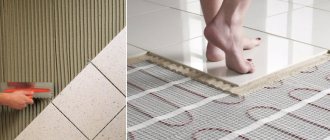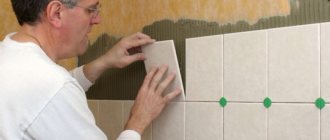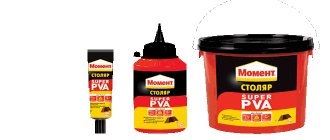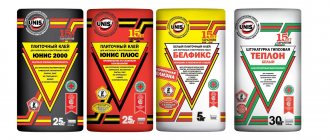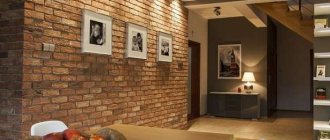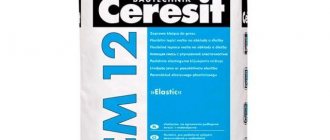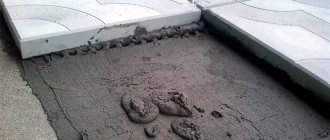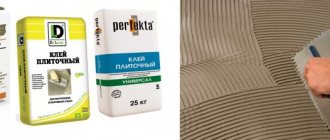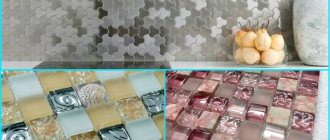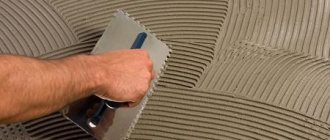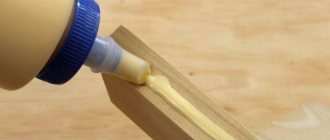Gypsum tiles are an excellent material for imitating natural substrates such as wood, stone and brick. The process of working with tile material is not very complicated, but you need to understand the intricacies of installation before you begin to repair the room yourself. One of the important points is the selection of gypsum glue; the strength of the structure will depend on its quality. Details about the adhesive solutions that can be used and their features will be discussed below.
How to choose the right tile adhesive
When finishing walls with tiles, you need to decide which adhesive is best suited for the tiles; because it depends on the structure of the material from which the tile is made, its dimensions, the type of surface on which it will be installed and the operating conditions.
Depending on the moisture absorption of the tile, its weight and mass, it is decided which adhesive to glue the tiles with.
Universal material
These additives, in a prescribed or reasonable amount, improve the gypsum mortar; however, building gypsum can be considered a universal material for the manufacture of materials that are subsequently subject to additional decoration (gypsum tiles, figured stucco molding, etc.). Therefore, additives to it are not necessary.
Types of adhesive for gypsum tiles
The advantages of tile adhesive are confirmed by its high quality, adhesive properties, elasticity, and ability to withstand loads arising from deformation of the base and the tile itself.
Choosing the best adhesive for tiles is of great importance in the area of its application: it can be a bathroom, a kitchen, a balcony, and the tiles can also be used to decorate a fireplace.
Depending on the place where the tiles are used, a special adhesive composition is selected taking into account certain characteristics.
Tile adhesive mixture can be divided into three types:
- Intended for use in both dry and wet areas, for external and internal work);
- It has additional characteristics, such as elasticity, resistance to temperature changes, and high air humidity. This adhesive can withstand loads and can be used for laying tiles on bathroom floors (class C2);
- The third group includes special heat-resistant tile adhesives used for stoves and fireplaces. This group includes high-strength and frost-resistant compounds.
Main characteristics of adhesive for gypsum tiles
Tiles and ceramics are part of our life. Tiles and ceramics exist everywhere we live. Sometimes we even change the tiles and ceramics in our home periodically, which entails a lot of expense.
Tiles are inevitable, especially in bathrooms. Although tiles are widely used in kitchens, many experts are strongly against the use of tiles in the kitchen; tiles are not used in the kitchen; In their opinion, tiles in the kitchen should be used only where there will be a gap for the hood.
Before answering the question of what is the best adhesive for tiles and tiles, I think it is necessary to briefly explain why it is preferable to use only the leading brands for bonding tiles and ceramics:
There are so many low quality products in the market. You just need to walk into a store to see a large abundance of brands, usually not of the highest quality.
Let's say you used a bad brand for tiles. This means that after a few years you will see tiles and ceramics sticking to the wall, and after a while they will start to fall off. As a result, one fine day you may witness the destruction of the interior of your apartment.
To carry out a traditional series of finishing activities, it is enough to use dry cement, a composition of sand tiles that has numerous advantages over adhesive paste:
- A wide range of adhesive-containing products of this type;
- High efficiency, ensuring reliable gluing of tiles to the base;
- Excellent mechanical properties;
- Reasonable price.
Selection options
To correctly select the appropriate adhesive, you need to focus not only on quality and cost parameters, but also on a number of other parameters:
- The type of base in which the entire spectrum will rotate, and its characteristic irregularities, such as deviations in vertical or horizontal lines. In order for the surface to be uniform in thickness, different amounts of glue will have to be used for different elements;
- Tile type. Determination of the level of its hygroscopic properties. For example, with a solid granite package with a low degree of hygroscopicity, it is better to avoid using adhesives with a high water content, otherwise this will complicate the evaporation of the liquid, which will reduce the reliability of the joint between the lining and the base. As tilers say in such cases, the glue under the tile “sours”;
- Tile sizes. Taking this parameter into account allows you to accurately determine the glue consumption;
- Tile surface. When laying tiles in the kitchen or in a room equipped with electric-heat floor systems, it is necessary to use adhesive as quickly as possible.
Under the influence of temperature fluctuations, the glue can shrink or expand, which is fraught with the most negative consequences.
General information. Varieties of decorative stones for wall decoration
The classification of decorative stones is quite simple - they can either be of artificial origin or natural. The latter, by the way, are highly expensive and therefore not so in demand. Especially if the budget is very tight. But artificial stones are a popular option, and they are presented on the market as the following modifications:
- Made from plaster.
- Made of concrete.
The first is most often used for finishing rooms, but they should not be wet. It can also be used to decorate external walls that are located under a canopy or even wide roof overhangs. The whole point is that gypsum is a hygroscopic material, namely it absorbs moisture well, and under the influence of which technical and also operational characteristics will decrease. But this type has its advantages:
The cost is relatively small.- Light weight, that is, it does not exert a small load on the wall surface.
- Convenience in installation work.
- Easy to cut to desired sizes.
The concrete version has higher strength, and therefore such stone can be laid in all rooms. But it is much more expensive than plaster and has much more weight. As for the variety of appearance, today there is material of artificial origin and natural, and all this is represented by a huge assortment. The main thing is to choose it correctly for the facade design or interior of the room.
Qualitative characteristics of adhesive for gypsum tiles
When choosing a suitable adhesive, you should pay attention to its quality characteristics:
- Ability to resist slipping. A composition with thixotropic properties prevents the complex coating from slipping to one degree or another. Most compounds do not allow tiles to slip more than 0.5 mm;
- Time of use. The time interval during which the adhesive layer, after application, retains its qualities and does not harden. The average length of an open path usually does not exceed 10-15 minutes. This time period can be extended by adding special ingredients to the glue that slow down the drying process. However, it is not recommended to do this unless necessary;
- Setting the cooking time. This is the time during which the stain can be corrected by completing adhesion to the surface material before the adhesive hardens;
- Time and adhesion of the base tile. There are times when quick action is required in rooms where work is being done on the wall, and therefore the composition should be selected based on the specific needs of a given room;
- Glue consumption. This characteristic directly depends on the size of the plates, the condition of the base surface and the larger or smaller width of the teeth. Practice shows that the average consumption is usually less than 3-4 kg per 1 m.
Required installation tools
For laying artificial stone, videos and photos serve as additional sources of information for any beginner. I will describe the step-by-step process of preparation and finishing. Before laying decorative artificial stone, you need to prepare the surface and the tools necessary for cladding.
Tools for laying decorative stone
First of all you will need:
- Drill with an attachment for mixing glue - dry cement mortar or special glue requires dilution.
- Building level.
- Metal brush.
- Rubber hammer.
- Syringe for grouting.
- Crosses and material for jointing - if a laying method with seams from 0.3 to 0.8 mm is used.
- Brush.
- Hacksaw and grinder.
Important! What to glue gypsum and decorative stone onto? Literally all bases are suitable for this: wooden, metal, brick, concrete. Polystyrene foam is used to insulate surfaces; it is covered with gypsum plasterboard or OSB.
